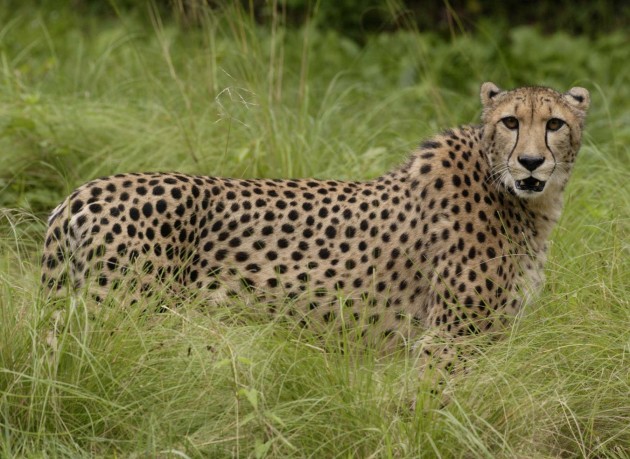Researchers at the Smithsonian Conservation Biology Institute have discovered why older females are rarely able to reproduce—and hope to use this information to introduce vital new genes into the pool. SCBI scientists and collaborating researchers analyzed hormones, eggs and the uteri of 34 cheetahs at eight institutions, and determined that while the hormones and eggs of cheetahs older than 8 years appear normal, the animals’ uterine tracks tend to suffer from abnormal cell growth, infections and cysts that prevent pregnancy.
“Those of us who work with cheetahs have anecdotally noted that it’s hard to reproduce older cheetahs, but this is the first time anyone has documented how aging affects the physiology of reproduction in this species,” said Adrienne Crosier, SCBI cheetah biologist and lead author of the study in which these results were published. “We were relieved to find that, unlike in other older mammals, the eggs in older cheetahs can produce viable-appearing and growing embryos, which means we may be able to transfer them to younger cheetahs and preserve genetic diversity. If we had found that the eggs were abnormal, we were facing losing genes in an already depleted population.”
The researchers’ findings were published in a paper titled Increasing Age Influences Uterine Integrity, But Not Ovarian Function or Oocyte Quality, in the Cheetah (Acinonyx jubatus) in the online version of the Biology of Reproduction in May and in final form this month. According to the study, approximately 80 percent of adult female cheetahs in North American institutions have never reproduced and the death rate for cheetahs has exceeded the birth rate in 13 of the last 16 years. Lack of genetics can lead to cub mortality and lower cheetahs’ resistance to disease.
The next step for SCBI researchers is to extract eggs from a cheetah older than 8 years that has not reproduced and to fertilize the eggs and transfer them to a younger female. Crosier estimates that SCBI will try an embryo transfer within the next two years and said that if it works, it is feasible that someday researchers could do this with wild cheetahs to continue to infuse the population in human care with new genes.
Paper co-author, Pierre Comizzoli, a vertebrate cryobiologist at SCBI, has been collecting and freezing immature eggs and ovarian tissues from felids for the SCBI’s Genome Resource Bank, a frozen repository of biological materials that includes sperm and embryos, tissues, blood products and DNA. Researchers are currently able to produce embryos from fresh eggs, but aim to do the same with frozen eggs.
“The work on freezing eggs and ovarian tissues will offer yet another option to preserve the fertility of females, especially long after they are dead,” Comizzoli said. “These approaches also allow us to to boost the number of offspring that can be produced from a single individual.”
SCBI is one of five centers participating in research to boost the cheetah population in human care as part of the Conservation Centers for Species Survival, also known as C2S2. All five centers collectively manage more than 25,000 acres of land devoted to the survival of threatened species with special needs (including those requiring large land areas, natural group sizes and minimal public disturbance). All five centers maintain a cheetah breeding facility as part of their long-term commitment to cheetah breeding and research. The Smithsonian’s National Zoo’s Front Royal facility currently houses 10 adult cheetahs and seven cubs. The National Zoo houses three adults.
Cheetahs, the fastest animals on land, are struggling to outpace threats to their survival in the wild. As the result of human conflict, hunting and habitat loss, there are only an estimated 7,500 to 10,000 cheetahs left in the wild. The International Union for Conservation of Nature considers cheetahs a vulnerable species.
The study’s authors from the Smithsonian Conservation Biology Institute are Crosier, Comizzoli, David E. Wildt and JoGayle Howard. The other authors are Autumn Davidson, Tom Baker and Linda Munson from the School of Veterinary Medicine, University of California at Davis, and Laurie L. Marker from the Cheetah Conservation Fund.








